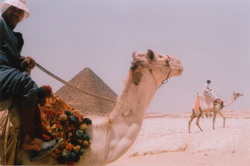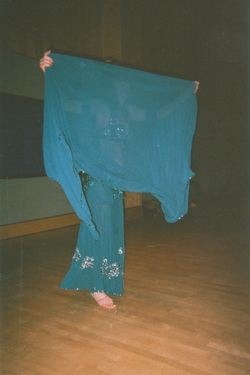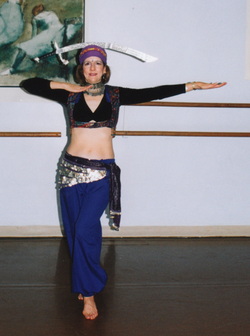As with camels, snakes are part of life in the Arabian Desert. It is no wonder their slithering undulations have been mimicked by dancers. As with camels, they are misunderstood creatures.
I will cover dancing with snakes in a future article. In this I will cover cobras, their characteristics and why they play a role in belly dance. They are not the type of snake one would ever dance with!
In Egypt, the Egyptian Cobra or Asp is one of the most common found in Africa. It was made most famous by Cleopatra who chose “suicide by snake bite” as her last act. The Pharaoh in Egypt wore an emblem with a wide-hooded cobra as a symbol of protection. In the Egyptian “Book of the Dead,” the cobra is a symbol of the earth. The famous Ouroborus sign shows a snake swallowing its tail as a sign of the circle of life. The cobra is also the distinctive emblem of the Kingdom of Lower Egypt in the Egyptian royal house. The snake goddess of Buto or Pe, an ancient sanctuary on the Nile delta was Wadjyt, a fertility goddess. Another snake goddess of the Nile delta was Wazel.
Snakes, serpents, cobras have attained a rather unsavory and unwarranted reputation throughout history, especially in Biblical history. In the Book of genesis, the snake represents deceit in the downfall of Adam and Eve. In the Book of Revelation, Satan is depicted as a serpent.
Yet, in non-Christian cultures in India and Southeast Asia, the snake is revered. Hindus consider snakes the manifestation of Shiva, the god of destruction and regeneration. Buddhists believe that a massive cobra spread its hood over the Buddha to protect him from the sun as he meditated. The images of cobras guard the entrances to many Hindu and Buddhist temples. On the Hindu’s annual lunar holiday of Nag Panchamij, Hindus refrain from plowing and field work out of respect for cobras.
King Cobras have been worshipped as sun deities and have been associated with rain and thunder.
Snakes also play an integral role in Cambodian, Greek, Nordic and Native American mythology. Snakes represent wisdom, knowledge, protection, sensuality, creativity, fertility and are phallic symbols.
The most sensuous moves of the dance are those that take their inspiration form the snake.In belly dance, head glides and cobra slides copy the movements of a hooded cobra. Rib articulations mimic the undulations of snakes as they move about the ground. Floorwork puts dancers in contact with the earth and many of the floor moves are snake-like. Dancers often hiss at other dancers in approval of the snake-like belly rolls, ribcage glides and head slides. Using the veil as a hood replicates the mystery of the cobra when a cobra stands and rears its head hooding itself (called uraeus) in a natural defensive posture, a warning signal to its enemies.
There are hundreds of types of cobras. They are venomous, not poisonous cold-blooded reptiles. Though they spew a deadly venom, they are edible to predators. The King Cobra is the largest and most venomous snake in the world. Found is most of Africa and Southern Asia, the cobra adapts to life in cultivated areas and villages. Though feared, when encountered they usually try to escape and avoid confrontation.
Cobras can not only bite but inject venom toward an enemy (usually aiming for the eyes). A King Cobra bite is the more serious than any other cobra species. Though about 45% of bites are blank (without venom), once bitten the mortality rate is about 10 out of 35. One bite can inject enough venom to kill an elephant. Men are bitten more than women, since more men handle snakes as a rule. A cobra bite cause immediate pain to the area bitten, tissue swelling, an altered mental state, nerve dysfunction, salivation, nausea, vomiting, paralysis of neck and jaw muscles, shortness of breath and chest pain. If antvenin (made from cobra venom) is not administered quickly, one would die. If one is spit in the eye, one suffer permanent vision problems or blindness.
Yet, there are still snake charmers who use cobras as a form of entertainment and income. Originally part of religious ritual, snake charmers were priestesses who dealt with women’s issues like fertility, menstruation (like a snake shedding its skin to begin anew) and conception. The figure of Minoan, a snake goddess, is depicted with hooded snakes in both her hands. Snake charming is now a handed-down profession, usually with men as charmers. The profession originated in India as a form of magic. Charmers understand the cobra and their behavior. They can predict a bite. Some cheat by illegally removing the fangs or venom sacs from their snakes for safety. When the lid to the basket is removed, the snake is essentially startled and takes on a defensive stance, the hooded cobra that we are most familiar with. They do not “hear” the music of the flute but react to its vibrations and mimics the moves of the charmer. In the US it is illegal to keep a cobra as a pet.
Cobras are intelligent, learn quickly, can “hear” through ground vibrations, are not blind and see very well at night and have superior smelling ability. They eat birds, fish, frogs, toads, lizard eggs, chicks from chicken coops, rats, rabbits and other snakes. They generally stay away from humans, realizing that humans are too large for them to swallow and digest. A large Kind Cobra can weight 35 pounds. They live 20 years and beyond.
The King Cobra is the only snake in the world that builds a nest for its young, on the ground. The female lays 20-40 eggs with an incubation period of 60-90 days. The male stays with the female and assists with nest duty, guarding and hunting. The “hatchlings” have enough venom to kill. The cobras only predators are man and the mongoose.
Isn’t it fascinating to learn about the symbols that helped create the magical art form of Middle Eastern belly dance?



 RSS Feed
RSS Feed